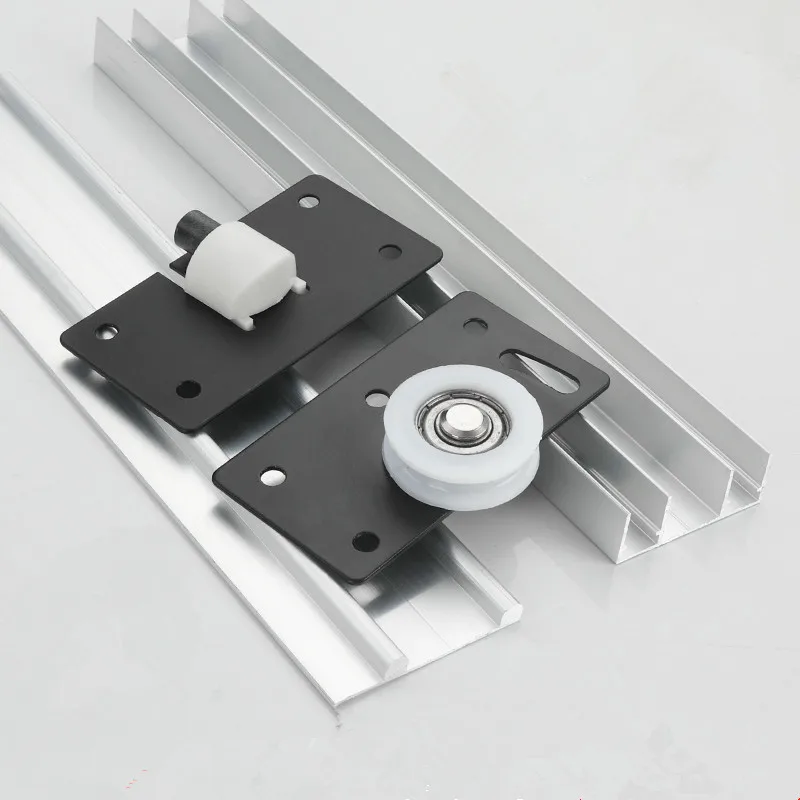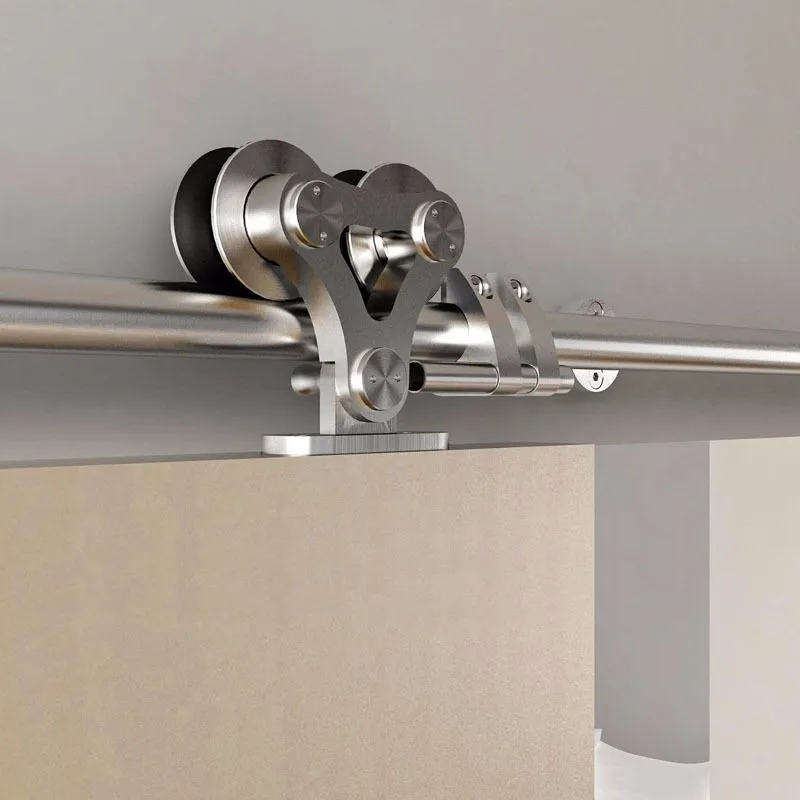Types of Cabinet Sliding Door Tracks and Rollers

Cabinet sliding doors offer a convenient and space-saving solution for various applications, from kitchen cabinets to closets. Understanding the different types of tracks and rollers used in these systems is crucial for selecting the right components for your specific needs.
Types of Cabinet Sliding Door Tracks, Cabinet sliding door tracks and rollers
Cabinet sliding door tracks are the foundation of the system, guiding the doors along their path. They come in various materials and designs, each with its own advantages and disadvantages.
- Metal Tracks: Metal tracks, typically made of steel or aluminum, are known for their durability and strength. They can handle heavy doors and offer smooth operation. Steel tracks are generally more robust and resistant to bending, while aluminum tracks are lighter and more resistant to corrosion.
- Plastic Tracks: Plastic tracks are a more affordable option and often come in various colors to match your cabinet’s aesthetic. They are lightweight and easy to install, but they may not be as durable as metal tracks and are less suitable for heavy doors.
- Concealed Tracks: Concealed tracks are designed to be hidden within the cabinet, providing a sleek and minimalist look. They are typically made of metal and require specialized installation, but they offer a seamless and modern aesthetic.
Types of Cabinet Sliding Door Rollers
Rollers are the essential components that allow the doors to slide smoothly along the tracks. Different types of rollers are available, each with its own characteristics and applications.
- Ball Bearing Rollers: Ball bearing rollers are known for their smooth and quiet operation. They consist of a metal housing with ball bearings that reduce friction and wear, ensuring a long lifespan. They are typically used for heavier doors and demanding applications.
- Nylon Rollers: Nylon rollers are a more affordable alternative to ball bearing rollers. They are made of durable nylon, offering smooth operation and quiet performance. While they are suitable for lighter doors, they may not be as durable as ball bearing rollers and can wear out faster.
- Steel Rollers: Steel rollers are typically found in heavier-duty applications and offer exceptional strength and durability. They are often used for industrial sliding doors and can withstand high loads and frequent use.
Common Types of Sliding Door Systems
Cabinet sliding door systems come in various configurations, each with its own advantages and features.
- Full Extension Systems: Full extension systems allow the doors to slide out completely, providing full access to the cabinet’s contents. They are ideal for cabinets with deep shelves or for maximizing storage space.
- Soft-Close Systems: Soft-close systems incorporate dampers or mechanisms that slow down the door’s closing motion, preventing slamming and providing a quiet and controlled closure. They are particularly beneficial for cabinets with heavy doors or in areas where noise is a concern.
- Concealed Track Systems: Concealed track systems, as mentioned earlier, offer a sleek and modern aesthetic by hiding the tracks within the cabinet. They require specialized installation but provide a seamless and minimalist look.
Installation and Maintenance of Cabinet Sliding Door Tracks and Rollers

Installing and maintaining cabinet sliding door tracks and rollers can seem daunting, but with the right tools and techniques, it’s a DIY project that can be tackled with confidence. This guide will walk you through the process, providing tips and tricks for a smooth and successful installation.
Installation of Cabinet Sliding Door Tracks and Rollers
Installing cabinet sliding door tracks and rollers involves precise measuring, drilling, and securing the components.
Here’s a step-by-step guide:
1. Measure and Mark: Start by measuring the width of the cabinet opening and the height of the door. Mark the locations for the track on the cabinet sides using a level.
2. Drill Pilot Holes: Drill pilot holes at the marked locations to guide the screws. The pilot holes should be slightly smaller than the screw diameter.
3. Secure the Track: Attach the track to the cabinet sides using screws. Ensure the track is level and securely fastened.
4. Install the Rollers: Install the rollers on the door. Most rollers come with instructions for attachment, which typically involve screwing them onto the door.
5. Align and Adjust: After installing the track and rollers, slide the door into the track. Adjust the rollers to ensure smooth and quiet operation. You may need to adjust the rollers’ height or position to achieve proper alignment.
Maintenance of Cabinet Sliding Door Tracks and Rollers
Maintaining cabinet sliding door tracks and rollers is essential for ensuring smooth operation and extending their lifespan.
Here are some maintenance tips:
1. Clean Regularly: Dust and debris can accumulate on the tracks and rollers, causing friction and noise. Clean the tracks and rollers regularly with a soft cloth and mild soap. Avoid using abrasive cleaners or solvents that could damage the surfaces.
2. Lubricate the Rollers: Lubricate the rollers periodically with a light oil or silicone spray. This will reduce friction and ensure smooth operation.
3. Check for Damage: Inspect the tracks and rollers for any signs of damage, such as cracks or worn-out bearings. Replace damaged components immediately to prevent further issues.
Installation Difficulty Comparison
| Track and Roller System | Installation Difficulty | Tools Required | Time Required |
|—|—|—|—|
| Basic Sliding Door Track | Easy | Drill, screwdriver, level | 1-2 hours |
| Soft-Close Sliding Door Track | Moderate | Drill, screwdriver, level, measuring tape | 2-3 hours |
| Full-Extension Sliding Door Track | Moderate | Drill, screwdriver, level, measuring tape | 2-3 hours |
| Heavy-Duty Sliding Door Track | Difficult | Drill, screwdriver, level, measuring tape, additional hardware | 3-4 hours |
Applications and Considerations for Cabinet Sliding Door Tracks and Rollers

Cabinet sliding door tracks and rollers are a popular choice for various applications, offering smooth operation, space-saving features, and aesthetic appeal. From closets and pantries to kitchen cabinets and bathroom vanities, these systems enhance functionality and organization in homes and commercial spaces.
Applications of Cabinet Sliding Door Tracks and Rollers
Cabinet sliding door tracks and rollers are widely used in various applications, offering numerous benefits for organization and aesthetics. Here are some common applications:
- Closets: Sliding doors in closets maximize space by eliminating the need for swinging doors, allowing for easy access to clothing and other items.
- Pantries: Sliding doors in pantries provide a sleek and efficient way to access food and pantry items while maximizing space.
- Kitchen Cabinets: Sliding doors in kitchen cabinets, particularly for upper cabinets, provide easy access to dishes, cookware, and other kitchen essentials while enhancing the overall kitchen design.
- Bathroom Vanities: Sliding doors in bathroom vanities offer a stylish and practical solution for storing toiletries, towels, and other bathroom necessities.
- Office Cabinets: Sliding doors in office cabinets provide a secure and efficient way to store files, documents, and other office supplies.
- Media Centers: Sliding doors in media centers allow for easy access to electronics and media while maintaining a sleek and modern aesthetic.
Factors to Consider When Selecting Cabinet Sliding Door Tracks and Rollers
Selecting the appropriate cabinet sliding door track and roller system is crucial for ensuring smooth operation, durability, and aesthetics. Several factors should be considered:
- Weight Capacity: The weight capacity of the track and rollers should be sufficient to handle the weight of the doors. Consider the materials and size of the doors when determining the required weight capacity.
- Door Size: The size of the doors, including their height and width, will influence the track length and the type of rollers required. Larger doors may require heavier-duty tracks and rollers.
- Desired Aesthetics: The aesthetic appeal of the track and rollers should complement the overall design of the cabinet. Choose a track and roller system that blends seamlessly with the existing decor or adds a desired touch of style.
- Installation Method: Consider the installation method, whether it involves surface mounting or concealed installation, based on the cabinet design and desired aesthetics.
- Budget: Set a budget for the track and roller system, considering the materials, features, and installation costs.
Common Problems Encountered with Cabinet Sliding Door Tracks and Rollers and Solutions
While cabinet sliding door tracks and rollers offer numerous benefits, they can sometimes encounter issues that affect their smooth operation. Here are some common problems and their solutions:
- Sticking Doors: Sticking doors can be caused by dirt, debris, or misalignment. Cleaning the track and rollers, adjusting the alignment, and applying lubricant can resolve this issue.
- Noisy Operation: Noisy operation can be caused by worn-out rollers, loose screws, or dirt accumulation. Replacing worn-out rollers, tightening screws, and cleaning the track can address this problem.
- Door Sagging: Door sagging can occur due to insufficient support or worn-out rollers. Installing additional support brackets or replacing worn-out rollers can prevent sagging.
- Difficulty Opening and Closing: Difficulty opening and closing doors can be caused by misalignment, worn-out rollers, or obstruction. Adjusting the alignment, replacing worn-out rollers, and removing any obstruction can resolve this issue.
- Track Damage: Track damage can be caused by heavy loads, impact, or improper installation. Replacing the damaged track section is necessary to restore functionality.
Cabinet sliding door tracks and rollers are a common feature in modern kitchens, offering smooth operation and space-saving functionality. But beyond traditional wood, there are innovative options for kitchen cabinets, like kitchen cabinets not made of wood , that can add a unique touch to your design.
These alternative materials, such as metal or laminate, can be just as durable and stylish, and often pair well with sleek sliding door systems.
Cabinet sliding door tracks and rollers are essential for smooth and effortless operation. While they are commonly used for traditional cabinet doors, they can also be a valuable addition to open kitchen cabinets no doors , providing a stylish and functional alternative to traditional hinges.
This allows for a seamless transition between open and closed states, adding a touch of elegance to the kitchen design.
